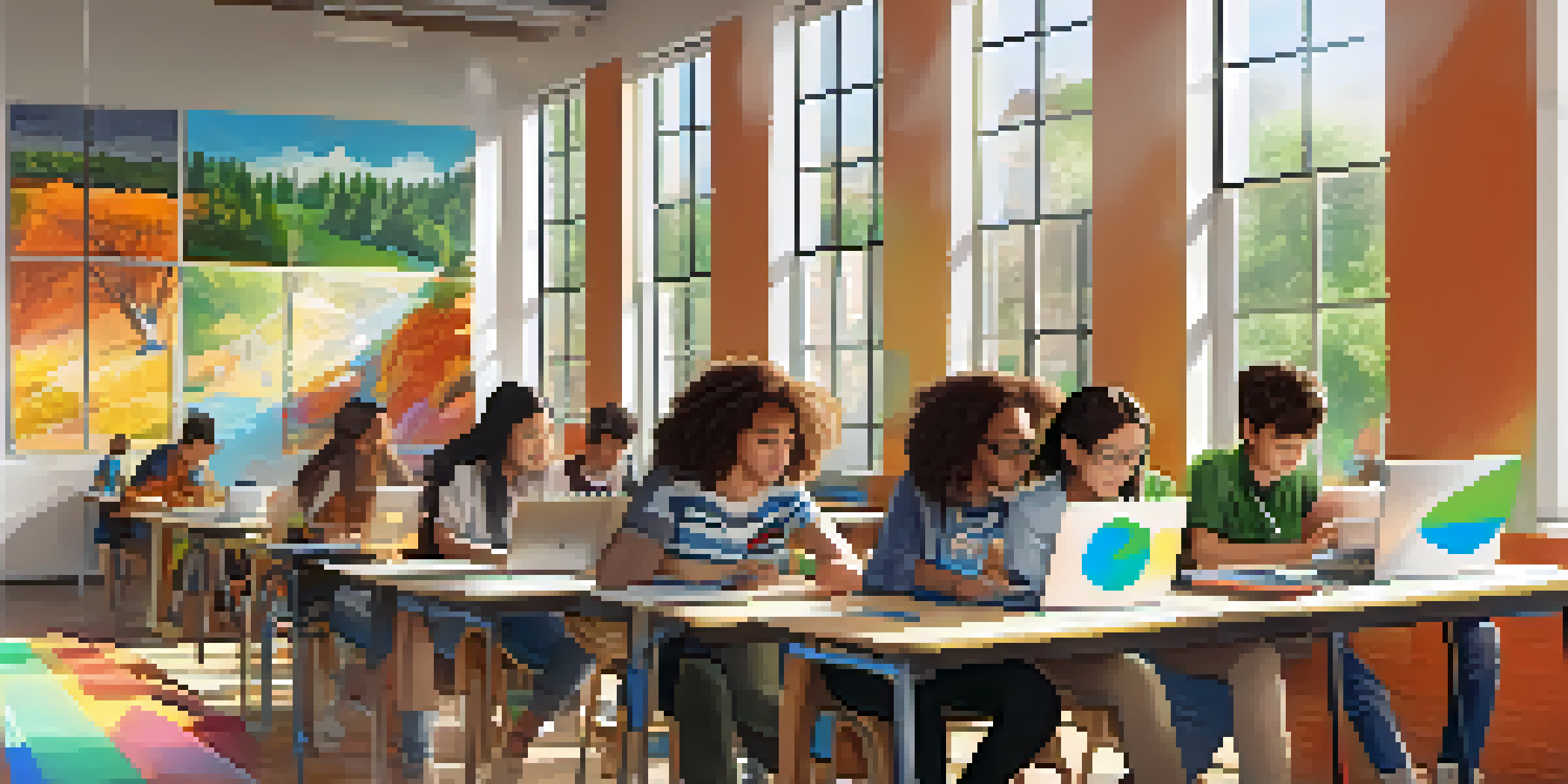Using Digital Portfolios to Showcase Student Learning

Understanding Digital Portfolios and Their Purpose
Digital portfolios are collections of student work that showcase learning progress and achievements. Unlike traditional portfolios, they are interactive and can include various media formats, such as videos, images, and essays. The primary purpose is to provide a comprehensive view of a student's skills and understanding over time, making it easier for educators and parents to assess growth.
Digital portfolios provide a visual representation of students' learning journeys, fostering deeper engagement and reflection.
These portfolios serve as a reflection tool, allowing students to evaluate their own learning. By curating their work, students can highlight their strengths and areas for improvement. This self-assessment fosters a sense of ownership and responsibility for their education, encouraging them to set personal goals.
In essence, digital portfolios bridge the gap between assessment and personal expression. They not only document achievements but also tell a story of learning that is unique to each student. This narrative aspect adds depth to the educational experience and engages both students and educators in meaningful discussions.
Benefits of Using Digital Portfolios in Education
One significant advantage of digital portfolios is their ability to enhance student engagement. When students know their work is being showcased, they often take greater pride in their efforts. This motivation can lead to higher quality work and a more enthusiastic approach to learning.

Another benefit is the development of 21st-century skills such as digital literacy and critical thinking. Creating a digital portfolio requires students to navigate technology, assess the quality of their work, and make decisions about what to include. These skills are invaluable in today’s tech-driven world, preparing students for future endeavors.
Digital Portfolios Enhance Engagement
Digital portfolios motivate students by showcasing their work, leading to higher quality outputs and a more enthusiastic approach to learning.
Finally, digital portfolios foster collaboration and feedback. They enable students to share their work with peers, teachers, and even parents, creating a supportive learning community. Feedback becomes more constructive as it is based on a visual representation of a student’s journey, rather than just grades or test scores.
Choosing the Right Platform for Digital Portfolios
When it comes to selecting a platform for digital portfolios, there are numerous options available. Popular choices include Google Sites, Seesaw, and Weebly, each offering unique features tailored to different educational needs. It's essential to choose a platform that aligns with your students' technological skills and accessibility requirements.
The best way to predict the future is to create it, and digital portfolios empower students to shape their own educational paths.
Consider factors such as user-friendliness, customization options, and the ability to incorporate various media types. A good platform should allow students to easily upload documents, photos, and videos while providing a visually appealing layout. This flexibility ensures that each portfolio can reflect the individuality of the student.
Additionally, choose a platform that supports collaboration and sharing. A portfolio that can be easily shared with teachers and classmates encourages interaction and feedback, enhancing the overall learning experience. Ultimately, the right platform can make the portfolio creation process enjoyable and effective for students.
Guidelines for Creating Effective Digital Portfolios
Creating a digital portfolio should start with clear guidelines that outline expectations. Providing students with a rubric can help them understand what to include and how to present their work effectively. These guidelines can cover aspects like content selection, organization, and reflection.
Encourage students to select a variety of work that showcases different skills and subjects. This could include essays, projects, art, or presentations. A diverse portfolio not only highlights a student's strengths but also demonstrates their ability to learn across various disciplines.
Reflection Deepens Learning Insights
Incorporating reflection in digital portfolios encourages students to think critically about their experiences and identify patterns in their learning.
Finally, emphasize the importance of reflection. Students should include written reflections on their learning experiences, discussing what they learned, challenges faced, and future goals. This practice deepens their understanding of the material and reinforces their learning journey.
Incorporating Reflection in Digital Portfolios
Reflection is a crucial component of digital portfolios, as it encourages deeper learning and self-awareness. Students should regularly take time to think about their experiences, challenges, and successes. This practice not only enhances their understanding of the subject matter but also promotes critical thinking.
By including reflective pieces, students can articulate their thought processes and the rationale behind their work choices. This narrative adds context to their portfolio and allows educators to gain insight into the student's learning journey. Reflection also helps students identify patterns in their learning, guiding them toward future goals.
Encouraging a culture of reflection in the classroom can transform the portfolio experience into a powerful learning tool. Regular discussions about the importance of self-assessment can motivate students to engage more deeply with their work, fostering a lifelong love of learning.
Showcasing Digital Portfolios to Audiences
Once students have crafted their digital portfolios, it's time to showcase them! Organizing a portfolio showcase event can be an exciting way for students to share their work with peers, parents, and educators. This not only builds confidence but also creates a sense of community and celebration around learning achievements.
Consider utilizing technology to facilitate sharing, such as video presentations or virtual exhibitions. This approach can make the experience more engaging and accessible, allowing a broader audience to experience the students' work. By leveraging technology, you can also encourage interaction through Q&A sessions or discussions.
Continuous Growth Through Portfolios
Digital portfolios are dynamic tools that evolve over time, promoting a mindset of growth and lifelong learning for students.
Highlighting student work can also inspire others and foster a collaborative atmosphere. When students see their peers' portfolios, they may find new ideas and perspectives, encouraging them to think creatively about their own work. Ultimately, showcasing digital portfolios can enhance the educational experience for everyone involved.
Continuous Improvement and Growth with Digital Portfolios
Digital portfolios should be seen as living documents that evolve over time. As students progress through their educational journey, they can continuously update their portfolios to reflect new learning and achievements. This ongoing process encourages a mindset of growth and lifelong learning.
Teachers can facilitate this by regularly revisiting and discussing portfolio content with students. These discussions can help students identify areas for improvement and set new learning goals. By involving students in their learning path, educators empower them to take charge of their education.

In conclusion, digital portfolios offer a unique opportunity for students to showcase their learning and growth. By embracing this dynamic approach, educators can foster a culture of reflection, collaboration, and continuous improvement that benefits both students and the wider educational community.